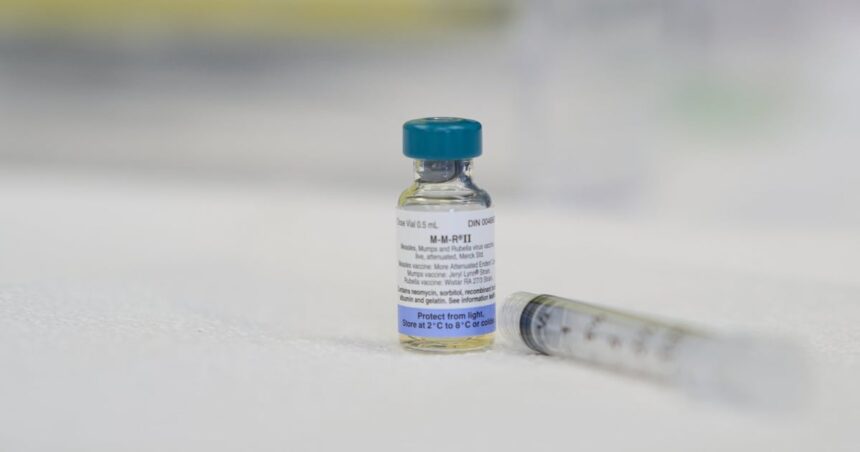I stepped off the Greyhound in Kelowna last Tuesday, just as Interior Health was quietly sending out their first alerts. By Wednesday morning, the coffee shop conversations had shifted from ski conditions to something I hadn’t heard discussed with such urgency in years: measles.
“My daughter’s daycare sent an emergency email last night,” said Maya Whitten, a mother of two I met at a local café near the hospital. “It brings back that pandemic anxiety, you know? Except this time, it’s something we thought was basically eliminated.”
Interior Health confirmed a case of measles in the region earlier this week, prompting a public exposure notification for several locations in Kelowna and Vernon between March 7 and 15. Health officials are now working to identify and contact individuals who may have been exposed to the highly contagious virus.
The infected individual visited Kelowna General Hospital’s emergency department on March 13 and 14, according to Dr. Silvina Mema, Interior Health’s medical health officer. “Measles spreads through air and can linger in a space for up to two hours after an infected person has left,” Dr. Mema explained during a hastily arranged press conference. “It’s far more contagious than COVID-19.”
This case emerges against a troubling backdrop of declining vaccination rates. According to the BC Centre for Disease Control, MMR (measles, mumps, rubella) vaccination coverage for kindergarten-aged children has dropped from 90.2% in 2019-2020 to 87.3% in 2021-2022. Public health experts consider 95% coverage necessary for “herd immunity” against measles.
The disease itself carries serious risks that many younger parents have never witnessed firsthand. Measles typically begins with fever, cough, runny nose, and inflamed eyes, followed by the characteristic rash that spreads from the face downward. While many recover without complications, the disease can lead to pneumonia, encephalitis (brain inflammation), and in rare cases, death.
“What worries us most is that measles is infectious even before symptoms appear,” said Dr. Kathryn Suh, an infectious disease specialist I spoke with at the University of British Columbia. “A person can spread it to others before they even know they’re sick.”
At Parkinson Recreation Centre, one of the exposure sites identified by health officials, I found maintenance staff implementing enhanced cleaning protocols. “We’re wiping down everything,” said Juan Moreno, a facility worker. “But it’s strange to think the virus could have been floating in the air here.”
For older residents like Dorothy Campbell, 72, news of the measles case triggered vivid childhood memories. “I had measles when I was seven,” she told me as we waited at a bus stop near the hospital. “Back then, it was something every child got. My mother put me in a dark room because the light hurt my eyes. I still remember how miserable it was, and my cousin ended up with hearing loss from it.”
The exposure notice includes specific locations, dates, and times:
– Parkinson Recreation Centre in Kelowna on March 7 from 8 a.m. to 12 p.m.
– Vernon Recreation Centre on March 9 from 10 a.m. to 2 p.m.
– Kelowna General Hospital Emergency Department on March 13 from 6:30 p.m. to 2:30 a.m. and March 14 from 7 p.m. to 11:30 p.m.
Interior Health advises anyone who was at these locations during the specified times to check their immunization status immediately. Those without immunity to measles who were potentially exposed should contact their healthcare provider or call the local public health unit.
Dr. Bonnie Henry, BC’s provincial health officer, noted in a statement that while Canada eliminated endemic measles in 1998, imported cases continue to occur. “The global situation is concerning,” she said. “We’re seeing outbreaks in Europe, Asia, and parts of the United States where vaccination rates have fallen.”
For vulnerable populations, such as infants too young to be vaccinated, pregnant women, and immunocompromised individuals, the risk is particularly serious. The health authority is offering post-exposure prophylaxis (either vaccination or immune globulin) to high-risk contacts if administered within six days of exposure.
At a local pharmacy, I noticed staff fielding calls from concerned parents. “We’ve had dozens of people checking their children’s immunization records today,” pharmacist Navdeep Singh told me. “Many don’t realize the second dose isn’t given until age 4 to 6, so their toddlers may only be partially protected.”
Communities in the region are responding with both concern and resilience. School districts have sent informational letters to parents, and some community events are implementing additional health screening measures.
Back at the café, Maya Whitten showed me her phone, scrolling through WhatsApp messages from a parent group sharing information about symptoms to watch for. “It’s crazy that we’re dealing with this in 2023,” she said. “But at least we’re better at communicating now. During COVID, we learned how to protect each other.”
As I walked through downtown Kelowna that evening, past the hospital where exposure had occurred just days before, the situation seemed to embody a broader story about public health in the post-pandemic world: the tension between returning to normal and remembering that some threats never truly disappeared. They were just held at bay by the vigilance we’re now at risk of forgetting.






